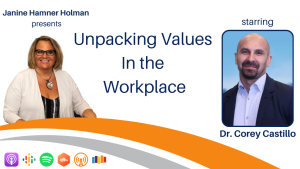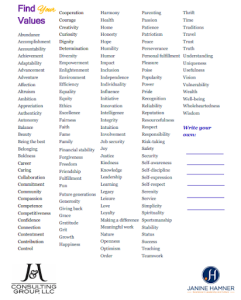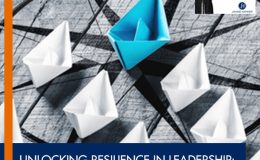
What are the values your organization presents as their own? Do they play an active role, and fit the company? In this episode, Janine Hamner Holman sits down with Corey Castillo, a business strategist and executive coach, to talk about the cost of misunderstood values.
GUEST: Corey Castillo | LinkedIn
HOST: Janine Hamner Holman | [email protected] | LinkedIn, Facebook, Instagram
What am I paying attention to today? I got a call yesterday from a potential new client. They have a strategic initiative around diversity, equity, inclusion, and belonging. Their organization decided to make it a big focus for next year.
This potential client called me because the organization has absolutely no plan. They don’t have any clear goals or milestones. She wasn’t even 100% sure what the pain point was, or the reason the organization decided this needed to be a big focus.
It’s one of the things I’m finding fascinating about what’s happening in organizations today in response to things happening in the world. Things happen in the world, and the organization thinks, “Okay, we need to respond to this somehow.”
They say, “We’re going to do this big thing.” But then, there’s no real idea of what it looks like. It ties to our conversation with Alyssia Gioscia, where we talked about how, if we don’t know where we’re going, how are we ever going to know when we get there?

I heard our guest for today talking recently about the importance of values. Specifically, the importance of organizational values as something that can really be a guidestone for an organization.
That’s part of what I think too. I think values and mission can be something that drives how an organization operates when it does the work to make sure those values permeate through the organization, that it’s part of people’s day-to-day experience in the organization.
With that in mind, I’m thrilled to welcome to the show Dr. Corey Castillo. He is a business strategist. He’s a law firm COO, and he’s an executive coach both within the law firm and outside of the law firm. He is dedicated to helping champions initiate new levels of personal excellence. Welcome to the show, Corey.
Yay. I’m happy to be on and happy to connect. I always love our conversations and congratulations on being on LA Weekly. I saw that earlier.
Thank you very much. I was just featured on LA Weekly as one of the CEOs and entrepreneurs helping to make new things happen. I was thrilled to be in that great company. There were 10 of us they picked, so thank you for that compliment.
Corey, what is something you have become aware of that organizations are not paying enough attention to, and what is the cost of that inattention?
I’ll jump on the values piece in terms of not necessarily paying attention to the why behind the what of decisions that are made either actively or passively. What I mean by that is, not knowing the base values and philosophies by which those ideas and decisions come from. One of the things I think is really distracting is a lot of the buzzwords.
You mentioned diversity earlier. That’s a buzzword. But what does that mean? Why does an organization that claims to want it… how does it philosophically fit into their values model and their operational model? What’s the net value it yields that’s favorable to them and their client base?
I know that a lot of organizations, and when I say organizations, I mean perhaps the leaders in those organizations, tend to very proudly say, “Our values are this in a promotable way.” My question is, where are those values evident? Because a lot of folks might select values with the intent to select words that sound nice, that are marketable, that are buzzwords that appear to be noble in some sense or another.
But where are they evident? Do they apply to all decisions at the individual level, and at the collective level? Are they usable as decision-making criteria we can verify in times of success and in times of failure as trusted criteria to lean on? Do they inform all of the decisions we make when we’re between a rock and a hard place, or maybe some ambiguity? Can we revert back to these values as a recipe of guiding principles to then scrub toward the ambiguity?

Part of what I love about that is, there’s a big difference between the concept of a value and working on figuring out, “What does that mean for us?” It’s easy for an organization to say, “Our values are teamwork and excellence.”
In reality, those words don’t mean anything without a definition attached. Then people can say, “Are we living by the value of teamwork? Are we living by the value of excellence? What does excellence look like here?” Because what excellence looks like here is going to be very different from what excellence looks like elsewhere.
Additionally, can I measure myself against a value called excellence? Am I being excellent? You’ve got to figure out what that looks, sounds, and feels like in people’s day-to-day experience.
Yes, it has to be verifiable. In starting that process, first we need to define the world as it is. When it comes to companies or organizations, it’s the world in which you compete. We can call it your market.
Then we need to define the world as we believe it should be. Now we have a to-from, then we need to, based on that, define our impact on it and what we actually go out to do to move it from what is to what should be. Then we have a framework to operate in.
From there we have to go through the recipe of qualities and principles that would equip us to move from what is to what should be. We’ll call those values. Our task is defining them to a point of specificity, by which case we can verify their existence.
In that process, we put together key examples of what they are and are not, because it’s really fun and uplifting to do that on the front end. If we don’t put in the rigor and specificity to inform ourselves down the road when we hit those spots of confusion and ambiguity, however, then they’re not going to serve as guiding values.
We’re basically designing the roadmap for ourselves, and we’re saying, “We know we’re going to get lost. We know we’re going to hit some market volatility. Are we being as clear, intentional, and precise with prescribing ourselves the criteria that’s going to get us out of the mud when we run into it? Are we accounting for all margins of error, misinterpretation, ambiguity, and chaos that we know we’re going to rub up against?”
One of my favorite examples is, I have gotten a few calls over the last number of years from CEOs who say some version of, “You know this thing is really important to us, that diversity is really important to us, that equality is really important to us. We have this one guy who’s just not willing to get on board. He keeps doing these things that are out of line with whatever that value is.
But here’s the problem, Janine. He’s our rainmaker, and we just don’t know what to do.” I respond with, “I get it. I get that tension.” Here’s the thing, there’s only two things you can do in that situation.
You can say, yes, we care about this value, and if we’ve done everything we can to get you on board with this value and you’re not going there, then we must part ways, or it’s not one of our core values, and that gets to be okay too.
If it’s not a core value, then what is it? If upholding and uplifting women is one of your core values, and this guy is a misogynist and pinches women’s butts… I’ve literally had that call. He pinches women’s butts and he says things that are inappropriate, and he tells people they’re beautiful or they’re a bitch or all of these things, and we’ve sent him to sensitivity training and we’ve done this and we’ve done that, and he just won’t get with the program.
Either you care about the experience of women or you don’t, and I’m not being moralistic about it. Either it’s important to you as an organization… forget about you as a human. Either it’s important to you inside your company or it’s not. If it’s not, and you will know it’s not if you’re not willing to let them go.
The proof is in the pudding in that sense. First it sounds like retention at all costs is a value, whether it’s acknowledged or not. That seems evident based on what you shared.
Secondly, whether he’s a man or woman, and whether he’s doing that with an audience that’s a man or a woman… is it a male-female thing or is it just a human-human thing? I don’t know what organization or what company might want that as a behavioral standard, not to mention the liability that it is, whether it’s a male or female. The question may come to: how much of a rainmaker is this guy…
How much risk is he putting your organization at? If he’s doing it internally, do you think he’s not doing it externally?

Yes. What does that imply? What are the consequences of that, as it pertains to not only direct liabilities, but branding, reputation, and folks possibly leaving because of that? It sounds like they’ve already deployed sensitivity training, assuming they didn’t move on helping him exit. It sounds like that didn’t work.
Then the conversation is, “If these are our values, which it sounds like they might not be, we’re going to proceed with retention. Either he gets in line based on a commitment, or he’s going to get on board by a sense of compliance, whether he gets it or not.”
That conversation needs to be through a sober lens, in that we can’t say, “If our value is this specific, and there’s a behavior that is in direct contradiction to it, that’s not even in a gray area. We’ve chosen to be inactive, so we have to have a sober conversation about them.”
To your point, not from a moral perspective, but just straight facts, here’s what it is. Then we build from that. If that’s an organizational culture where it’s a little bit of the wild west and folks can do whatever, then acknowledge that and take the good with the bad. You’ve got rainmakers, but then you carry liabilities.
Certainly there are many organizations with that mindset. My husband used to work for one of the biggest tech companies out there. It was a dog-eat-dog world. People did and said all kinds of things that were massively inappropriate all of the time. No action was ever taken. They were willing to roll with the liability.
They also didn’t have big posters up in their lunchroom saying, “Our value is teamwork.” Because clearly their value was not teamwork. They had made a very clear decision, either consciously or unconsciously, that “This is how we believe the best work is going to get done.”
I believe in the long term, they are not correct, but they continue to churn through people and they’re incredibly well known. Everybody’s clear on what their culture is. There’s no gray area.
I like that. I like the objectivity about it because… starting with what we spoke about a few moments ago where some folks might choose to gravitate towards buzzwords that sound good or noble. The underpinning to that is, there’s a subtle moral posturing that comes with that decision.
Whether we’re talking on behalf of a company, a brand, or individuals, they should be looking at it objectively and saying, “Here’s a liability I have. I’m not casting a judgment on it. Here’s an asset. I’m not casting judgment on that either.” It’s up to you on the trade off you want, and it’s up to you to determine how you’d like to compete in your market. If there’s a competitor of yours with a different approach, that might be a change up on what you’re running with. Are you accounting for that?
Approaching it objectively is advantageous because a lot of folks might look to posture, and at that point, are we really solving for something that’s real? Are we chasing our tails based on something that appears, on a surface level, to play well?
Speaking of playing, I would like to play with you a little bit. One of my beliefs, based on my experience, revolves around values and clarity, especially now with the pressure the Millennials and Gen Zs are putting on the workforce to have work that is meaningful, to understand how their work connects into something bigger.
I believe it’s part of the foundation of the house to be really clear on what your mission is, maybe what your vision is, certainly what your values are. I’m curious, for you, both at the law firm for which you’re the COO, and within all the consulting you do and have done in the past, do you resonate with that, that having your mission and values clear is a foundational element organizations get to be clear on?

Yes. Absolutely. The reason for that is, as social beings, we find meaning with, through, and alongside each other. Having this kind of tribal component to our nature and being pack hunters, if you will… There has to be a common philosophy we share.
Those connecting points are based on shared beliefs, ideas, and experiences, in that order. The tighter the belief is, the closer the bond is. The tighter the ideas are, the closer the bond is. The more congruent experiences there are, the tighter the bond is. It’s really important.
One of the things I do tend to emphasize though is, it is both party’s responsibility, meaning companies need to be clear on that, so as to attract the right audiences they want to hire.

It’s also the individual’s responsibility to know that for themselves. At the end of the day, while the organizations we work in can provide that for us, what we experience in our own lives is our responsibility as well.
We have to account for an openness. We have to account for thinking through our own personal mission, vision, values, and our own lives. That way, when we are presented with that with a company, we can be confident that those align and that we can make sure we’re lifting our own weight in taking care of the way we like to live our lives.
That’s one of the points I emphasize. It’s not just the individual. It’s not just the company. It is a shared reciprocity between both.

Absolutely. I’m working with an organization right now, and we’ve been working through a list of values. The value statement is about core principles that create a compass for the organization and its employees.
When done well, values can guide decision-making and establish a framework. The important question is, “What are the values that are unique to our organization? What is the experience of employees in embodying that?”
This is a list from the book I recently published called Mind The Gap. It’s a list of close to 100 different values. Everything from wellbeing to power, to influence to equality, to appreciation.

One of the reasons I created that list is because I think people can get stuck if they haven’t ever thought about, “What are my values?” They can get stuck in trying to get going. I have an exercise in the book that runs people through the process of, read it first, then go through and circle all the words that appeal to you, then narrow it down, then narrow it down from there. How do you do that?
If we have 100 words, that won’t be helpful in guiding us. We need a narrow band. When you are helping people figure this out, and part of where I was going with that is, we do it for individuals and for the organization at the same time so they can be thinking, “What is my experience in the organization?”
Just like you said in the beginning, they can ask themselves, “What is my experience now? Where would I love it to be? What’s the bridge? What’s the gap to get us from here to there? As I’m thinking about it for the organization, how do mine, and this may be the first time I’m thinking about it, how do my values I’m now discerning connect into that?”
What are your thoughts about that?
The first thing is, when we select, let’s say five values that we speculate might be our values, then we have to ask ourselves, where’s the evidence for those values in our lives? Let’s look back at the last 10 decisions made of any magnitude, and look at what is implied there.
I’ll share an example I did… a few years back, I was working with an engineering firm that had 22 values. I said, “We need to bake that down. That’s too much for us to navigate. Let’s put it down to five and keep it around there.” We did that and one of them was creativity. I wondered how that worked for an engineering firm.
That’s awesome and interesting.
I said, “Help me understand the evidence for this. Because you’re an engineering firm, you’re dealing with gravity and physics, which only has so much room for creativity, and you have structural guidelines you have to adhere to within your contracts and building code. That is non-negotiable. Where’s the creativity in that?” Ultimately, through a few questions, we figured it wasn’t necessarily creativity they thought they were talking about. It was safety.
We ran it through a line of scrutiny. On the other side of that came out safety. My next step was, “Now there are two questions. One, what led us to just shoot for this word, creativity? Why were we attracted to that without really investigating it?” We had that conversation. From there I said, “Now the evidence we investigated supported the concept of safety.” Safety is not the sexiest value. It doesn’t sound that great, but it’s real.
For an engineering firm, I mean personally to me, it sounds pretty sexy. I’d like the building I’m in to keep standing up, thank you very much.
True. Another way of saying that is, it’s not the most colorful value, as compared to creativity. For every organization, it’s starting with that initial list and then scrutinizing them with evidence that is arguably sound and reasonable in defense of the claim that any particular value is their value. Safety stood up to that scrutiny far more than creativity, so we swapped that and adopted safety as a value.
Do you remember anything about what they learned when they were seeking to discern? What was it about creativity that had them drawn to that word in the first place?

I can’t recall off the top of my head, but I think it was about internal collaboration. If I remember correctly they reasoned, “We creatively go about our day, put things together, and make do with what we have. We’re creative with limited resources.” There’s some merit there, but does that value span the scope that safety does? It didn’t for them.
How different is that from what any other organization of your size, scope, and range is doing? I think that can be one of the things that can be so great about this exercise. I was looking at the results of a survey we did with about 400 CEOs. We were asking them their top three concerns: “What’s the thing waking you up at 3:00 AM?”
In that top three for everybody in that group, the worry was some articulation around staffing. Recruiting and retaining the right, the top, the best talent. We are in this space, and it appears this space is not going away, this great resignation people were talking about more a number of months ago, it is continuing.
People are continuing to quit their jobs at the rate of 4 million people in the U.S. every month. That is almost double what it has been historically. While we are in this place, discerning values that are unique in some way to your organization, whether it’s the word or the definition you use, can be part of what differentiates one organization from another. It can be part of the employer branding of an organization to attract and retain the best talent.
I think a lot of organizations are fighting to secure that identity and competitive differentiation in their markets to attract the right audiences for the purposes of the right retention. As they do that, I know there were a lot of headlines of the great resignation in the talent war, and I try to get past the sensationalism of those headlines because I think those headlines don’t contribute.
They don’t make anything better in that there is a lot of movement. I don’t think there’s much of a great resignation, I think there’s more of a great shift. If you resign from one place, you’re going to go to another.
I don’t know if we call it a talent war or a talent market. A defensive approach might be inferred when calling it a talent war. Then the question is posed: are you competing for the right reasons or do you just show up and say, “Hey, this is who I am.”
I’m not looking to get into a “war”. I’m looking to put up a flag on who we are and how we operate and trust that doing so authentically and transparently is going to attract audiences who are in alignment with who we are and where we’re going. The rest of the supposed war can be fought by those who want to go to war.
Absolutely. One of the things I love about you and I love about our conversations is, you are so diligent about language because words are in fact so formative and the words we use about things matter. That’s something I strive to achieve as well.
Whether it is the great reshuffling we’re talking about, the great reprioritization, or something more positive than the great resignation and something more illustrative and brings people in certainly more than a concept like war does, I’m all for it. That’s one of the things that’s been hopefully a silver lining, we’ll see as it plays out with COVID-19 and with the isolation so many people were experiencing, is that people have an opportunity to reevaluate and figure out what’s key for them.
One of the things I’ve been working with a couple of different organizations around is the endemic situation right now. Employers want employees to come back, employees want to stay home and work from home.
How do you balance that? How do you figure out the roles and the functions we need people in the office for all the time? What are the collaboration opportunities where we really do want people together? How does it make sense for people to be in that place?
As a chief operating officer, where are your struggles, challenges, and opportunities in that realm?
I know this has been a popular subject around how to offer perks of employment, if you will, considering remote work a perk. In many senses, it’s become an expectation, and that might differ from company to company, industry to industry, or market to market.
It’s accounting for all variables in that decision, because there are some companies with an office expense they’re locked into for multiple years, and they have to make use of the space. There are some with a client base that actually necessitates in-office visits. There are some that don’t. There are some companies with similarities across all roles, in that all roles can be remote, and there are some with a mixed bag.

Variation in role type and function needs to be taken into account. Different state labor laws also come into the mix. Companies can go remote and call it half or fully remote, but is there a difference for someone working remotely down the street, or two states away?
Are there labor laws we have to be cognizant of? Are there time zones? If someone goes to the other side of the country, are they still going to be operating in our time zone because that’s where our business is? Are there any variables we have to consider around time zones?
To take it back to values and identity in that a company has to ask themselves, what do we believe around culture and the physical presence of that culture? That is to say, working in-office versus that culture reformatted in a remote presence.
What are the costs and gains to that, both explicitly as it pertains to financial costs and an office occupancy, and implicit costs? That is to say, to production, engagement, and cross-departmental collaboration. Are we willing to assume those costs?
From there organizations need to be transparent about it up front in interviews. If folks say, “Is there a fully remote option?” It’s either a yes or a no. I find a lot of companies are fumbling and saying something like, “It could be, we’ve got a policy.” Then you look at the policy and it’s super ambiguous, and their response is, “We’ll figure that out.” That’s a recipe for a disaster.
There are a few examples, let’s start with a trash company. The guys and gals who drive trucks, they cannot pick up our trash remotely. They have to be in the truck to pick up the trash. Customer service could be remote. There’s also access to contracts and things that make it easier if people are in the office.
I can’t have my teeth cleaned by my dental hygienist through a remote interaction, that’s got to be in person. There are some things that just have to be in person.
As you were talking about human beings, ultimately there are three things we seek. We seek safety, we seek belonging, and we seek dignity and respect.
When we can figure out how to create those things within our organization, and then whether people are in the office or remote, how does that impact the culture? How does that affect the culture? Many organizations are having to figure out “What are the key things in our culture we want to perpetuate, and how do we do that now in a situation where some people are physically together and some people are not?”
Again, having that conversation in a very sober way, not trying to be all things for all people, just to please as many folks as we can in the short term at the expense of long term functionality, is vital. There have been a lot of folks with that stumbling in the short term, and they just kick the can down the road, and have the same issue a year later. Perhaps it got worse because it wasn’t addressed with any sense of decisive action.
If you’ve brought on a lot of people for whom it’s critical to them that they are remote, and then you end up deciding, no, everybody’s got to be here, you’re going to have a lot of pain. With everything, it’s so much better if you figure it out in the upfront.
That’s why it’s important to manage perks versus expectations. I think it was Microsoft that started with everyone being remote five days a week. Then, I think it was a year later, they decided everyone was back two days a week. A year before, being remote three days a week, and in office two days a week would’ve been amazing. Because that became the standard base expectation, going back to two days a week wasn’t going to work.
All those people are pissed.
Consequently, I’m sure there are organizations on the other side with the approach of, “I’d love to come back, depending on their work culture and employee base.” Navigating that, I guess one of the questions organizations would have to ask themselves is, is this a temporary pivot?
If so, how do they communicate that with transparency? Is it something they are willing to adopt as long term, at least for the foreseeable future? If they ever have to try to rein it back, are they willing to endure what comes with that?
I hope our readers have enjoyed this conversation as much as I have. Corey, as always, it has been a joy, a pleasure, and an honor to be with you. I so appreciate you and your wisdom, your insights, and your perspective. Thank you so much for joining us.
Thanks so much. I’ve enjoyed it.
Awesome. I am Janine Hamner Holman, and this has been The Cost of Not Paying Attention. Remember, great leaders make great teams. Until next time.
Important Links
Mind The Gap: A Thought Leader’s Guide to 21st Century Conscious Leadership
About Corey Castillo
Dr. Corey Castillo is a Business Strategist and Executive Coach with proven results in revenue growth and quality enhancement across multiple industries. From Health & Fitness to Corporate Philanthropy, Professional Services, Healthcare, Law, and a variety of other fields, Corey has taken an interdisciplinary approach to aligning “people and processes” to deliver value-based, scalable, and sustainable results.
His record is a reflection of his ability to strategically segment opportunity, design value, reduce waste, scale operations, optimize talent, and cultivate a high-performance culture.
As an Executive Coach, Corey is among the top 5% and considered one of the most versatile top tier executive coaches, with a private practice dedicated to partnering with company leaders, entrepreneurs, artists, and business owners on achieving their personal and professional goals.






